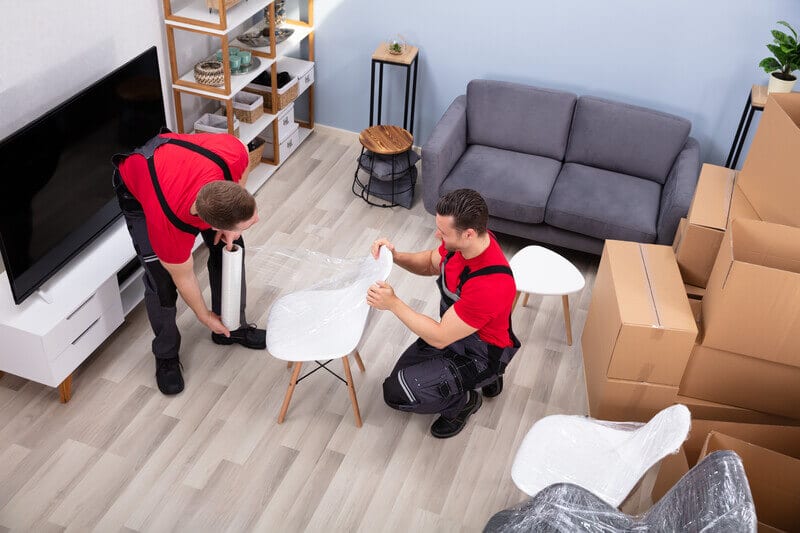Plastic wrap, which is often referred to as shrink wrap and stretch wrap, is a vital resource for either professional or DIY move. Stretch wrap can solve many moving-related issues, from furniture protection to securing doors and loose wires. It will not only protect your furniture, but it will also help pack large belongings like furniture and rugs so that you have enough space in the moving vehicle for other items.
But, how can you use plastic wrap for moving? In this post, we will run fast check on ways to make use of plastic wrap for moving. Firstly, why plastic wrap?
Why use a Plastic Wrap for a Move?
Plastic wrap, or shrink wrap is one of the highly important packing supplies to have on hand when getting your items ready for moving. Below are the reasons for the choice of plastic wrap:
- Plastic stretch wrap is so much versatile: It can protect your furniture from scuffs and scratches, prevent dust and dirt from getting to your items, pack items together, hold loose cords and wires in place, keep protective wrappings in position, prevent spills, and so on.
- Strong and wear-resistant: Even with its thin look, stretch wrap (and especially professional-grade moving wrap) is a bit strong and wear-resistant, so it can survive much tension and protect your belongings (even large and heavy ones) during the whole moving process.
- Ease of use: Packing plastic wrap is safe for your belongings and is easy to use. It adheres to itself, but not to surfaces (unlike packing tape, it doesn’t have adhesive backing), so it won’t leave back sticky residue or cause any form of damage to the fragile surface of your furniture and other household belongings. Because of its clingy nature, the application of stretch wrap can be a bit tricky, but it is a bit straightforward to apply and so much convenient to remove.
- Affordable and available: Plastic wrap is cheaper and available in different sizes, so you can easily get the perfect type of cling wrap for your packing requirements and get as much as enough.
Environmentally friendly: Packing wrap can be recycled, so you don’t have to worry about the effect of your move on the environment.
How to Apply Plastic Wrap for Moving Furniture
The use of plastic wrap for moving is intuitive: similar to how you use packing tape. But there are some tricks to doing it perfectly. Below is how to make use of stretch wrap for furniture to ensure that it is protected for your move:
Clean and dry your furniture:
Ensure everything is properly clean and dry before you use a stretch wrap for furniture. Stains and scratches can arise from wrapping debris or dirt on your item. For couches or other upholstered furniture, vacuum and wipe using a damp cloth. Allow it to dry before you wrap this furniture. For wood furniture, use a dry cloth to wipe off dust. Vacuum leather pieces with a soft attachment, wipe down using mild soap and water and finish by applying leather conditioner. Allow it to dry before you wrap.
Disassemble your furniture:
Before you apply stretch wrap on your furniture, remove all removable parts to ensure your pieces are easier to load and haul. Remove table leaves and tabletops and chair legs. Use moving blankets to wrap table leaves and secure using plastic wrap and tape. Roll the legs of the chair in a moving blanket to enable each leg to be covered by the blanket. Make sure parts are not touching each other. Use tape and plastic wrap to hold the outside.
Using stretch wrap is simple:
As you are packing furniture with heavy pieces, such as a china cabinet or sofa, have a long strip of stretch wrap tucked in a safe place (such as in a drawer or a crevice). Hold the roll on the interior of both ends, and take a walk around the item, allowing the roll to unwrap. It should hold the tucked strip into place.
Be aware of furniture edges:
Regardless of the sturdiness of your furniture or appliance, corners are often prone to damage during a move. But it is not only your furniture that is prone to get damaged. Corners that are not protected can scrape against doorways and walls – something you don’t ever want in your new home. For more protection, apply plastic wrap for packing items to hold foam padding or cardboard before you wrap your furniture in moving blankets and more plastic wrap.
Secure drawers and doors using plastic wrap:
Whether you remove doors and drawers before you move them or not, plastic wrap is so much essential. After removing doors or drawers, wrap them in a moving blanket and hold them with plastic wrap. If you leave doors and drawers on your items, you can cover them using plastic wrap and tightly. Create a rope-like strand and tie it to a handle or have it shut in the drawer or door. Wrap the item many times to hold all movable openings in place.
Other Ways to Use Plastic Wraps When Moving
Holding Packing Items in Place
Large or small, all your belongings will need to be wrapped up using some packing material or the other. Larger furniture pieces will be wrapped up in bubble wrap or moving blankets, while smaller furniture items will be secured using packing paper. But you can load on any amount of protective material as you want; it is pointless till you secure it.
There is a list of items used to hold on packing material, such as cord, strings, tape, or packing tape, including straps. However, the safest of these is the use of plastic wrap. Wrap about 3-4 rounds of the stretch wrap around the objects, tightly pulled to stretch but not tight to the point that it rips.
Ensure the edges are pushed on tight to stick to the plastic wrap, and you are all set. You can also use plastic wrap to wrap smaller furniture pieces and appliances. This not just holds the packing material, but works as a total covering from dust and moisture.
Moving in Bad Weather
Having to work around the weather is one of the stresses of moving. If you are performing an offseason move, you will need to look into whether it may rain or snow during your relocation. And regardless of the number of times the weather forecast indicates ‘clear’, there will always be a freak rainfall or snowfall to mess up your move. In this case, you need to consider waterproofing, which is where you need the plastic wrap.
Due to its flexibility and waterproof feature, plastic wrap is one of the best materials used to protect your expensive items from the elements. Our general recommendation is to cover all your items with a thick layer of plastic wrap after you have fixed all other packing material. However, if you are worried, you can often wrap your items in plastic wrap, then continue by applying the packing material, and finally be covered by the plastic wrap once again.
The only issue is that if moisture finds its way in, it can lead to a fungus or mold growth. Make sure the plastic wrap is held tightly, and be extra careful if you are combating the weather. Choose climate-controlled storage if you are concerned about unloading in the bad weather, postponing it until the weather clear.
Valuable Items
Packing items of extraordinary value is usually tricky. Delicate or strong, you want to ensure the items are safe during the move, but you also cannot just go stocking up packing materials. Also, one rule to observe when packing expensive items is to avoid using tape and newspaper to prevent damaging the surface with glue or ink stains.
In this case, just secure the item using enough packing paper, and wrap it up using plastic wrap a few times around. Ensure you cover it completely with plastic wrap, allowing no open gaps or spaces. And if you are concerned about the wrap coming loose, just fasten the ends down using strips of tape.
There is no reason you can’t apply tape on plastic wrap, and it only holds down the plastic wrap even more. Just make sure to be more careful when unwrapping it, just sniffing off the tape and not damaging the items accidentally.
Fastening Loose Items Tightly
The small pieces that get loose during the move are the unexpected enemy to your shipments, colliding with everything and causing damages to surfaces. One easy way to avoid this and to keep items of similar shape together is to make use of plastic wrap.
Below is a rundown on how to get this done:
- Hangers: Because of their odd shape, hangers can be hard to pack. Have someone hold around five hangers that have a place and hold them with plastic wrap to protect them. You can also make a hole in the plastic to allow the hooks to pass through or ensure they are wrapped on.
- Parts: Whether it is appliances or furniture, you want the entire parts to be intact and in their original places while on the move. Before loading the bubble wrap, cover it up using one-or-two, or plastic wrap.
- Small oddly-shaped items: Trust, you will find lots of these odd items during your move. Door knobs, bed rails, curtain hooks, and tools can all the packed together.
- Hanging clothes: Hanging clothes should be packed a bit differently, which is why we’ve ensured to mention it in our article. Instead of personalized covers or trash bags, you also can make use of plastic wrap around the clothes to protect them from dirt.
- Wires: Instead of tying the wires with thread or cord, just wrap a few sheets of plastic wrap around them. This covers the wires from dust and moisture, making sure they keep their functionality.
Packing Jewelry
There are lots of ways to pack jewelry effectively when getting ready for a move. The easiest way to transport them is to buy a jewelry box, but you can just perform easy DIY. The use of plastic wrap to pack jewelry is effective for necklaces and long earrings. Spread out a sheet of plastic wrap and place the jewelry on it lengthwise, placing them in a stretched-out manner. Ensure you leave a bit of space between them. Place a same-size plastic sheet over the first sheet.
With your fingers, press the sheets together around individual jewelry, with the bit of space you left earlier. This makes sure that your necklaces are in one place without getting tangles as they can’t move around. Now you can fold up the sheet to gently slide it into a box or a bag without get6ting worried about any entanglement or damaged jewelry. Use the same process for long earnings.
Spill-Proof Bottles
Acetone, aftershave, nail polish, face toners, makeup remover, just name it, many leaks can’t wait to happen while on the move. These containers can sometimes break under pressure or can leak open if there is any chaos that occurs to the caps. Irrespective of what it is, just protecting your furniture from leaks is not the only thing; you also ought to prevent leaks.
If there are screw-on lids on the containers, just remove the lid and place a piece of plastic wrap on the mouth. Screw on the lid and apply a rubber band around the plastic for a tight wrap. If you are still bothered, wrap the whole bottle in a plastic wrap layer and tape everything together.
Where can I Get a Plastic Wrap?
The good news is, plastic wrap is easy to come by. Rolls of plastic wrap are available at your local Home Depot, Walmart, Office Depot, and Lowes. You can also find it on Uline.com and UHaul.com. We’ve worked with two various providers, UsedCardboardBoxes.com and Uboxes.com, to assist you in buying the important moving boxes and packing materials at the best prices
Other Important Packing Materials
- Cardboard boxes: When you are moving, you will need so many cardboard boxes to contain your items. Just ensure your heavy items are placed in small boxes and light items inside large cardboard boxes.
Check Top 5 Places To Buy Cheap Moving Boxes in 2022
- Plastic bins: Clear plastic bins are the waterproof way to safely pack electronics. Considering that they are transparent, you will also be able to quickly find your items without sorting through all your boxes.
- Peanuts: Even though these are messy to handle, peanuts give lots of cushioning in moving boxes and can be so much helpful in protecting belongings while on the move.
- Moving blankets: When moving furniture, appliances, and musical instruments, moving blankets are important. They not only offer protection from rain and weather elements, but they also secure your house and items from getting banged up or scratched while moving.
- Dolly: Planning to transport a bulky appliance or a heavy piece of furniture? You will need to rent a dolly or hand truck to assist you in moving them out the door. You can get dolly rentals only at UHaul.com or you visit Home Depot’s moving equipment rental service to get them. If you choose to buy a dolly, they are available at Lowes, Walmart, and Home Depot.
- Towels: No moving blankets available? Convert your old beach or bath towels. Towels are a convenient and cheap way to provide an additional layer of protection to your items during a move.
- Foam: Foam is ideal for protecting fragile china and delicate glassware during your moving process. It also works as a great choice for other protective materials. Foams are available in the shape of foam pouches custom-made to fit certain items, or you can buy them in sheets from Amazon or Uline.com.
FAQ About Guide to Making Use of Plastic Wrap for a Move
It can prevent your furniture from scuffs and scratches, package difficult-to-pack goods such as bed rails, and firmly hold moving blankets on furniture. Because plastic sticks to itself, but not to surfaces, plastic wrap is ideal for bundling and protecting goods without damaging or leaving adhesive residue.
The mover’s plastic wrap from U-Haul is perfectly used to bundle, bind, and fasten while relocating and storing. This wrap can be used differently, such as wrapping a dresser or cabinet to prevent the doors and drawers in position, to keep belongings together such as silverware or other kitchen items.
Packing plastic wrap is safe for your belongings and convenient to use – since it sticks to itself, but not to any surface (as contrary to packing tape, it doesn’t have adhesive backing), so you won’t see a sticky residue on your item or any damage to the fragile furniture surface and other household goods.
Beginning from the top of the Television, make use of 2-3 layers of bubble wrap to wrap the center of the television to create a protective layer on the screen. Use a piece of foam to pad each corner of the TV. Hold it with packing tape. Spread out a moving blanket, and place a television flat in the middle of the blanket making sure the screen side faces up.
As recommended by the FDA, plastic wrap should not come in contact with the food. You will have to maintain a gap between the upper surface of the food items as well as the plastic wrap. The use of plastic wrap is safe; however, it cannot come in contact with the food items inside the microwave during heating and cooking.
Hiring Professional Movers
Certainly, you can usually find professionals to wrap and pack your items for moving. The good news is, there are lots of moving companies and shippers who specialize in packing and performing these things. To locate them, you don’t have to stress yourself further than Adams Van Lines. All our movers are experienced, which implies that you are in great hands.
If you are asking How Do I Make Long Distance Move Easier? Check our Trusted Long Distance Moving Services.



